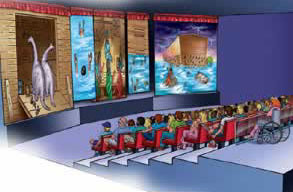Pinchas: Realizing the Goal
Creationist Museums
The debate about Creationist Museums sparked my interest. Creationist Museums apply scientific methods to prove the biblical account, but it is the integrity of these methods that many in the scientific community have called into question.
The media had a field day with the debate, pitting paleontologist against creationist. I wasn’t surprised by the vehement opposition of the scientific community, but by the hollowness of their argument. Rather than debating the evidence and the arguments presented in these museums, they negated the very rights of these museums to exist.
“Creation,” charged a paleontologist from Alberta on CBC radio, “has always had its venue in the church, why have creationists entered the scientific arena? (1) “Museums are about open ended inquiry, where you don’t have the answers when you begin,” said Nica Lelli, Educator for the Metropolitan Museum. “These museums had the answers before they began and then did their research to fit it together.“ (2)
Needless to say, this attempt to shut down the opponent rather than address their argument didn’t strike me as open minded. (3)
Creationist Museums are also being attacked by many in religious circles, who argue that supporting faith with scientific evidence undermines its status as absolute truth. It reduces faith to just another argument. Faith need not be bolstered by science, they argue. It ought to be strong enough to stand alone.
I believe that each of these arguments contains a kernel of truth and that each plays a role in the Jewish perception of creation. On the other hand, Judaism also poses powerful resp onses to each of these arguments.
onses to each of these arguments.
The Jewish Perspective
Jewish mystics teach that G-d deliberately concealed himself from the world he created. To protect his obscurity, he ordained that empirical science be powerless to detect him. (4) Yet, he didn’t want a G-dless world; he wanted us to seek him out despite our lack of evidence. He wanted us to peer through his deliberate veil of obscurity and embrace him.
On the other hand, G-d didn’t want our embrace to be motivated by religious duty alone; he wanted creation itself to support a belief in its creator. He wanted to be visible through his handiwork despite the remarkable lack of evidence. (5)
Two things are therefore true. Scientific evidence cannot by itself lead to the definite conclusion that G-d’s exists. If it did, G-d would have failed in his quest for a world from which he was concealed. It is equally true, that when we know what to look for we should be able to find empirical telltale signs of his existence. If we couldn’t, it would be impossible to embrace a G-d we could not know.
Because empirical science doesn’t easily yield its telltale signs of G-d’s existence, acceptance of G-d must begin with independent conviction , a conviction we call faith. However, once we believe in G-d it is possible to embark on a tour of scientific exploration with the stated objective of finding G-d. (6)
The Debate
Returning to the debate, each of the arguments contains a kernel of truth. Faith doesn’t require scientific support and the quest for such support weakens it. This is true. Our conviction in G-d’s existence doesn’t begin with science and shouldn’t.
But on the other hand, our conviction doesn’t end with faith either nor should it. Our duty to our creator is to ensure that he doesn’t remain absent from his creation. It is incumbent upon us to bring G-d out of the church and seek signs of his existence in his handiwork.
Creationist museums do not pursue open ended inquiry because open ended questions don’t lead to the existence of G-d. This is true and it is true by design.
But on the other hand, just like complicated mazes are easily solved when we work our way backwards from the end, so is the quest for G-d, who has hidden himself in a web of complicated mazes. The only way to find him is to first identify what we are looking for and then to initiate the search.
This is not a matter of fitting evidence to a predetermined thesis, but of knowing what to look for. Indeed, if the paleontologist doesn’t agree with the findings, the debate should be vigorously pursued. We don’t do G-d any favors by manipulating evidence for his existence. It is our duty to seek him out through fair and objective methods. (7)
Removing the Veil
This fusion of science and faith was demonstrated to our ancestors when they entered the promised land. Before distributing the land to the twelve tribes, they first surveyed the land and divided it into equitable portions. Larger tracts of land were assigned to more populous tribes and smaller tracts were assigned to less populous tribes. (7)
They assigned these tracts, but didn’t actually allocate them till they threw lots. This was an odd thing to do. What if a smaller tribe would end up with a larger tract and a larger tribe with a smaller tract?
The lottery was a reflection of divine will. Our ancestors were not content with apportioning land according to their own understanding, they wanted to be certain that G-d agreed with them.
This, however, begs a question. If they were going to throw lots and leave the distribution to G-d, why did G-d instruct them to undertake a scientific survey and a purely hypothetical allocation of the land?
This may have been G-d’s way of demonstrating that faith and science should not be treated as separate entities. Faith should play a realistic role in our lives and science should be play a realistic role in our faith. It is wrong to believe in G-d in our house of worship, but to keep him out of our land allocations. It is equally wrong to rely exclusively upon G-d when allocating the land and neglect our duty to scientifically survey it.
The Ultimate Solution
In truth , I too agree with the Paleontologist. I too am dissatisfied with the methods that Creationist Museums are, by necessity, required to adopt. I would be far happier if open ended inquiry and objective pursuit of empirical evidence could, by itself, lead to the conclusion of G-d’s existence.
In fact, a time will come when this will become the case. Our prophets promise that in the messianic era G-d will be fully revealed. We will gaze upon nature and actually see its creator. At that time knowledge and faith will fuse; believers and scientists will join hands. G-d’s existence will become a fact; one that open ended inquiry will lead us toward and that empirical science will openly endorse. (8)
Footnotes
- CBC radio interview, “The Current,” hosted by Anna Maria Tramonti, March 30, 2007.
- Fox News interview, May 29, 2007.
- To be fair, these particular comments were the exception rather than the norm. Nevertheless, I have yet to hear a single legitimate discussion of the arguments brought forward by Creationist Museums. Many scientists have assured us that creationist science is faulty, but these scientists never explain what makes it so.
- See Tanya, (R. Schneur Zalman of Liadi, founder of Chassidus Chabad, 1745 – 1813) Shaar Hayichud V’haemunah, chapter 4–6.
- We won’t find proof of a creator, but we we should be able to discover telltale signs that reinforce our faith in creation. We should also be able to refute any arguments that attempt to disprove G-d’s existence.
- See Tanya chapters 37. See also Likutei Sichos (R. Menachem M Schneerson, Rebbe of Lubavitch, NY, 1902-1994) XVII, pp 95-99.
- The one argument I cannot agree with is that, which shuts down debate. The argument that faith belongs in the church, but not in the museum is faulty. I agree that faith has always had its venue in the church, but who is to say that it must stay there? It seems to me that bringing faith into the museum and demonstrating that it doesn’t necessarily conflict with science is a good thing. The argument that the science in creationist museum is faulty because it doesn’t entail open ended inquiry also lacks credibility in my opinion. There is nothing wrong with identifying the answer you seek before you set out to find it. It may not be an open ended method, but it is a legitimate form of exploration.
- Numbers 26: 52-56.
- Isaiah 40: 5. See Tanya Chapter 36. See also Likutei Sichos XVII, p. 93.

























